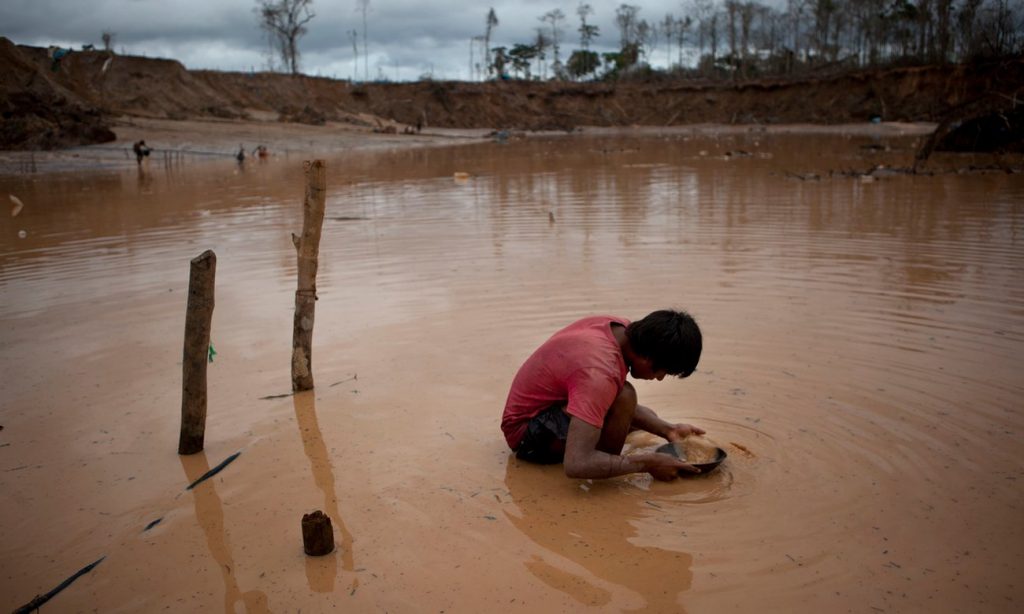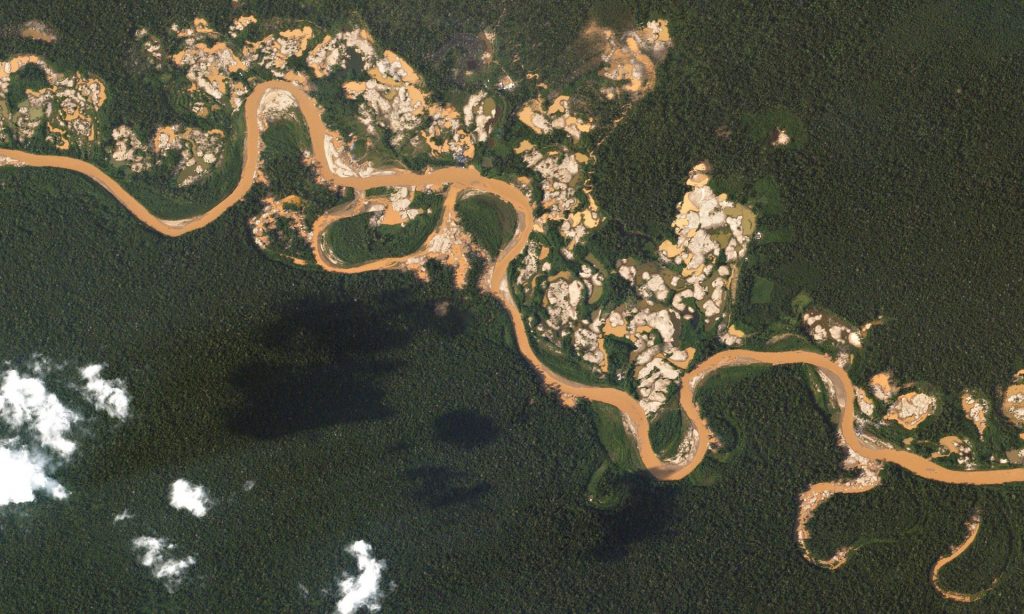
Photograph: Rodrigo Abd/AP
Oscar was 16 when his cousin “sold” him to the owner of an illegal gold mine deep in Peru’s Amazonian jungle. Life in Madre de Dios – a huge encampment scarred by deforestation and mercury-filled pools – was dirty, desperate and dangerous: food and water were scarce; malaria and yellow fever were rampant; and trafficked girls as young as 12 worked as prostitutes in the surrounding bars.
Business, however, was booming. Fuelled by the huge global demand for gold, thousands of miners like Oscar trawled over the hills with wheelbarrows and pickaxes, finding metal that would eventually pass through various intermediaries – from criminal groups to corrupt exporters to Swiss refineries – before ending up in a jewellery shop, a smartphone or even a central bank anywhere in the world.
Gold is Peru’s primary export, worth an estimated $3bn (£2.3bn), yet violence, corruption, laundering and exploitation – including debt bondage, human trafficking and child labour – within the industry are rife across Latin America’s illegal gold mines, according to a report by fair labour NGO Verité. With global gold reserves nearly exhausted, and prices up by 360% in the past decade, this massive supply-and-demand imbalance has fuelled organised crime syndicates looking for new sources of revenue, researchers say, with the result that Peru and Colombia – the world’s top cocaine exporters – now earn more from illegal gold exports than cocaine exports.
Traceability is a major concern, says Verité’s CEO, Shawn MacDonald, as Latin America accounts for 20% of the global gold supply. Yet some of the world’s most active paramilitary and organised crime groups are directly involved in the production and sale of this illegal gold, from the Farc guerrilla group in Colombia, to Mexico’s Sinaloa cartel and Italy’s ’Ndrangheta mafia, as well as Chinese, Brazilian and Russian syndicates. Illegally produced gold is laundered and exported with the help of corrupt officials, sent to refineries, melted down with legally produced and scrap gold, mixed to make alloys, then exported worldwide. Verité’s research found that 90% of the Fortune 500 companies that filed conflict mineral disclosures last year – in industries from telecoms and IT to car makers and machinery manufacturers – had purchased gold from refineries linked to illegally mined gold from Latin America.
“America imports far more gold than many of these Latin American countries claim has even been mined,” MacDonald said. “Up to 87% of Colombia’s gold exports – and 91% of Venezuela’s – are illegally produced. Illegal mining is controlled by illegal groups backed by large-scale investments enjoying profits in the hundreds of millions, even billions, of dollars.”
While the US and Canada are the largest importers of Latin American gold, Switzerland is responsible for refining at least 70% of the gold produced worldwide, says Thomas Hentschel, of the Swiss Better Gold Initiative. A movement to mine “fairer” gold already exists, yet Verité says some companies are using this to their advantage. “What we’ve seen is that some Swiss refineries have stopped purchasing gold from these suppliers linked to illegal gold mining and human rights abuses,” said MacDonald, “and we’ve seen US refineries coming in and … purchasing the gold instead, which is very worrying.”

Photograph: Planet
The US-based Global Initiative against Transnational Organised Crime (Gitoc) – which has also researched into illegal gold mines in Latin America – claims the industry needs a massive slimming down to help clean up.
“Fewer intermediaries in the supply chain will help regulate the industry,” said Gitoc’s Livia Wagner, who adds that exporting and importers need to look more closely at their supply chains and be held accountable for any discrepancies and abuses within them.
For Oscar, who has contracted malaria, yellow fever and a fungal infection while working in Madre de Dios, there is no way out. The nearest town is a five-day journey away by canoe, and debts incurred for his medical care have forced him back to work in the mines. While his wages are sometimes paid in gold, they are not the “chunks of gold” his cousin had promised he’d earn; instead, they are small rocks that dishonest gold buyers tell him are worth far, far less than he’d hoped.
Gold: rare, versatile, costly … and destructive
Gold is a rare earth metal in serious decline. Only one in a billion atoms of rock of the Earth’s crust are made of gold, yet nearly 75% of its stocks are already gone (pdf). Increasing demand for jewellery, electronics and banking has seen production double since 1970. Gold is used in many things, from smartphones, laptops and TVs, to dental fillings, rings and rockets.
Gold is valuable because it is both rare and extremely versatile. Known by the Aztecs as the “excrement of the gods”, it has bejewelled, enriched and enslaved humankind for millennia. And while gold can be found on nearly every continent, the total amount that has been mined in the past 6,000 years could only fill two Olympic-sized swimming pools.
So prospectors are looking at digging deeper – under the sea. This is where most of the Earth’s gold is stored – roughly 20m tonnes. In 2014, massive tracts of the Pacific seabed were opened up to mining companies looking for rare metals. Last year, China – which with India is the largest consumer of gold – discovered a 470-tonne gold reserve 2km below the East China Sea, and is trying to develop new drilling technologies to get it.
Gold mining on land has long depended on toxic chemicals such as cyanide and mercury for extraction, which threatens human and aquatic populations. In illegal mines, the use of these chemicals often goes unchecked. If gold mining goes underwater, critics fear that oceans – already severely damaged by overfishing, climate change and pollution – will be irreversibly damaged by the destruction that mining brings.

